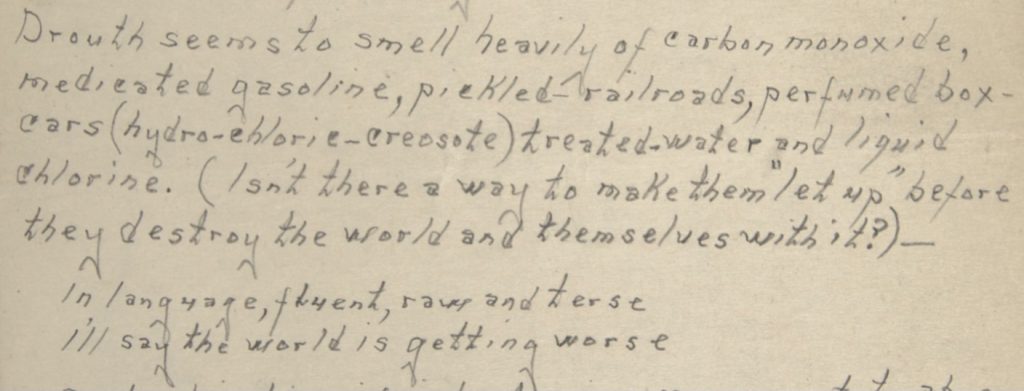Author: John Westmoreland
Creosote Boxcars
Since December 2017, when I first discovered that T-Bone Slim is my great granduncle, I’ve endeavored to learn as much as possible about his life and work. In my experience perhaps the best resources to accomplish this are the columns he authored for IWW periodicals, as well as the existing handwritten manuscripts housed at the Newberry Library and in my family’s archive. However, since the topics of T-Bone Slim’s writings are focused on contemporary events and issues of his day, and because he writes in a rather surrealistic and free flowing manner, understanding and contextualizing his work is not always an easy task—there are many references which could slip past a researcher. I’ve found that one useful way to gain insight into what T-Bone Slim is expressing is to take note of particular words or phrases found in his writings and to use internet keyword searches to find other content containing the same references. This tactic helps to elucidate T-Bone Slim’s perspective and often provides fascinating parallels to issues of importance in our society today. This blog post will be an investigation into one such word—“creosote.”
In the Franklin Rosemont – T-Bone Slim Research Collection at the Newberry Library in Chicago, there is an undated handwritten manuscript which can also be viewed via their online archive of T-Bone Slim papers, approximately 1934–1942 (pages 79, and 81). True to T-Bone’s characteristic elusive style, it is really up to the reader to decide exactly how much one believes he is making definitive claims here, or if the message should be taken to some degree in a tongue in cheek manner.
“Drouth seems to smell heavily of carbon monoxide, medicated gasoline, pickled railroads, perfumed-boxcars (hydro-chloric-creosote), treated-water and liquid chlorine. (Isn’t there a way to make them “let up” before they destroy the world and themselves with it?)—
In language fluent raw and terse
I’ll say the world is getting worse”

Creosote in the 21st century
In an article from the Gothamist—a New York City online news, arts and entertainment outlet—published August 10th, 2011 residents of Queens, New York express concern over a nauseating smell emanating from the railroad tracks in Middle Village. According to one resident, “The odor is so bad it can choke a horse… You smell it for a while and you start to get woozy.”
T-Bone Slim in his manuscript describes a dark and “ill smelling fluid… which exudes fumes for six months, possibly years without recharging”. He states that this substance was used to line the interiors of boxcars, and that for the hobos traveling and sleeping in such cars, it amounted to a “death penalty” or at the very least an “accelerated dispatch to a haven of rest”.
“Death penalty seems rather a heavy punishment to lay on a man for sleeping in a box car. Such is the punishment however, the end slightly deferred. Here it might be argued the punishment is not a death penalty in so far as it lops off only the closing years of the slumberers life and might be classed as accelerated dispatch to a haven of rest. Be that as it may, here is how it is accomplished:
The cars are doped with an ill smelling fluid; with but few exceptions. We won’t go into the nature of the stuff, sufficient to say it makes the homeless one ill. We won’t go into the motives, which are many and all pointing in one direction; sufficient to say the evidence is in those cars, a dark shade, stain, which exudes fumes for six months, possibly years without recharging. Freight moved in those cars becomes as contaminated and the noble businessman and householder hasten to make their wills—noble martyrs to the cause of brainlessness!”

What to do with “pickled” railroad ties?
Over the past couple decades aging creosote treated railroad ties have at times been burned in large scale incinerators and biomass energy plants in the United States to create electricity. Through this process railroad companies are able to grind down and dispose of tons of hazardous old ties which would otherwise have to be stored in industrial waste sites. This solution, however, elicits concern among some residents and environmental groups in the areas surrounding the energy plants which burn these creosote “pickled” railroad ties. For instance Flagpole, a local magazine in Athens GA published an online article from January 27th, 2020 featuring a video of members of the Madison Clean Power Coalition holding a protest against the burning of creosote treated railroad ties by the Colbert, GA Biomass Energy Plant over concerns that the smoke produced is toxic and poisoning the air.
Whatever one makes of the controversies related to creosote and its continued usage, it is certainly fascinating to see how issues which concerned T-Bone Slim 80 to 100 years ago are often still quite relevant and topical in our society today…